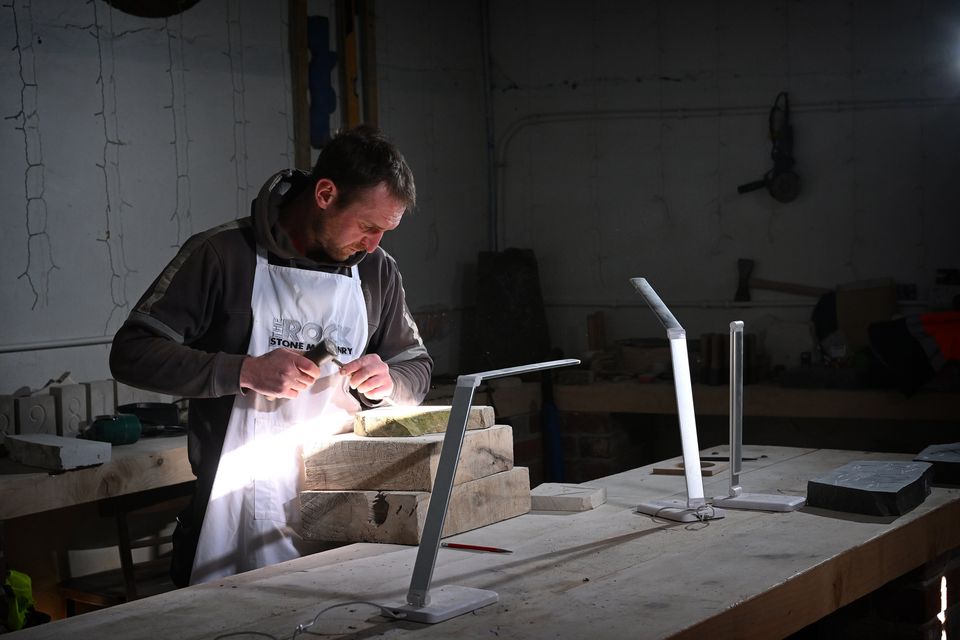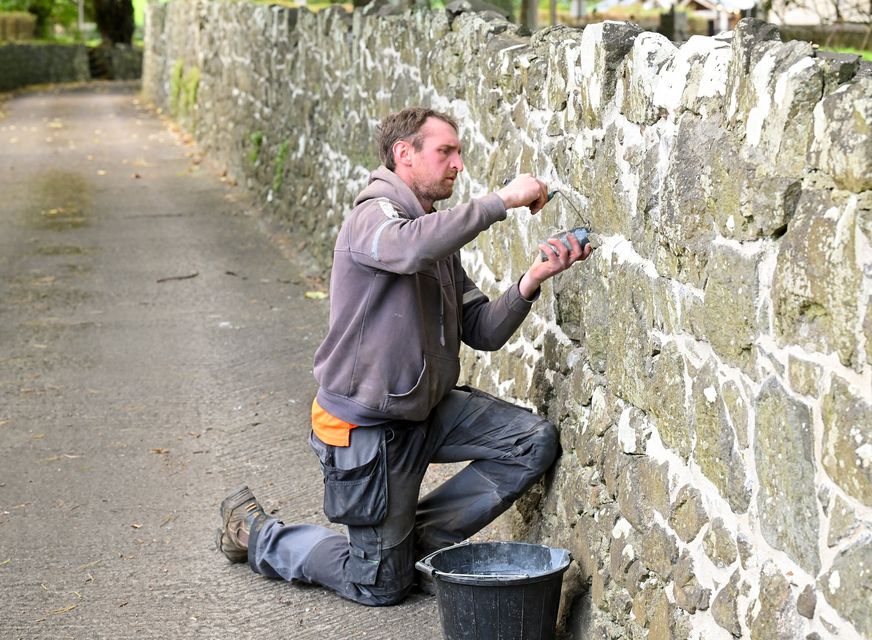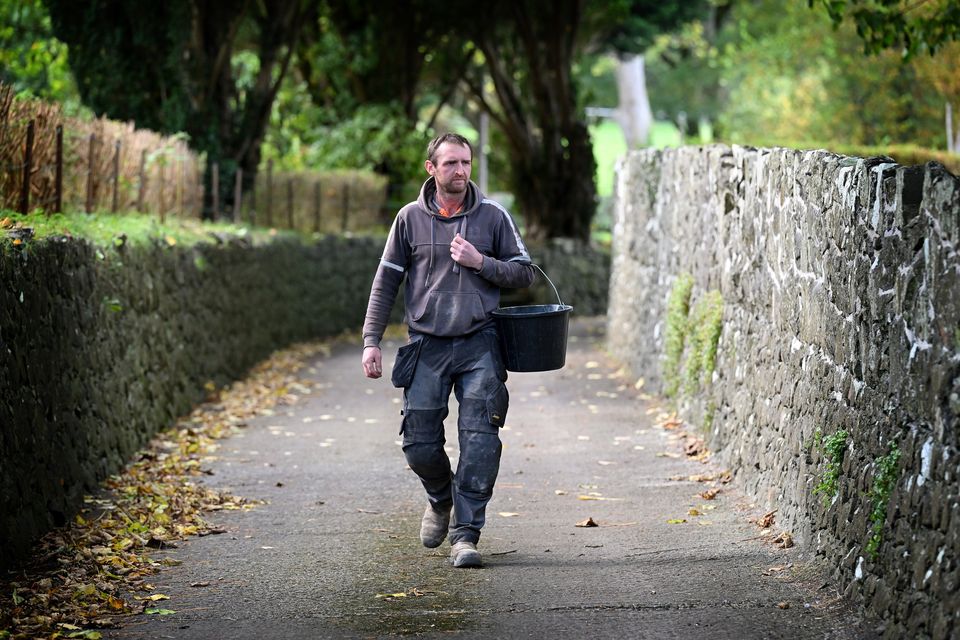Stonemasonry is one of the oldest indigenous crafts in Ireland making up the bones of historical buildings like castles, farmhouses and other centuries-old structures.
A heritage stonemason like Nathan Morrow is tasked to upkeep these historic buildings and ensure they continue standing.
Nathan (37) is a stonemason by day and farmer by night working out of his workshop in Glenarm, Co Antrim. His farm ‘The Rock’ stretches back six generations to when his ancestors first took up the land.
“We would have been here since the 1600s. The Rock family farm was actually a plantation farm I believe,” he said.
Nathan was the first of the family to take up stonework as a profession but says it was something his family always had to do.
“I spent my childhood and adolescence with my father and grandfather, building drystone walls on the farm,” he explained. “So when it came to the point when I had to find a career I thought about trying to learn to do this properly.
Nathan Morrow in his workshop at The Rock Stone Masonry, Glenarm Castle in County Antrim. (Credit: Stephen Hamilton)
“The walls started falling down that I built throughout my youth so I said ‘let’s try and do this right’.”
“The father said why don’t you give stonemasonry a go? I think it was because I was very good at breaking stuff.”
He decided to pick up a chisel and hammer more than 20 years ago learning from a stonemason in Ballyclare, realising very quickly that he’d found his passion.
Read more
“I remember after the first week we were punching granite. I came back home with my hands curled up into the shape of a chisel, my hand was bruised and pretty much purple — but I loved it,” he said.
“I loved the aggression to the finesse. You could put effort into chipping the stone, but you had to do it properly.”
Since then, Nathan has sharpened his skills and provides a wide range of masonry services including requests from private clients, construction and restoration of listed buildings.
“Once I started to really get to the grips of it working with different stones, carving, sculpting and monument work, that’s when you had to learn your strike,” he said.
“And you never stop learning in masonry — because you’re always looking back on how things were done to rephrase it.”
The Rock Stone Masonry at Glenarm Castle in County Antrim (Credit: Stephen Hamilton)
In 2020, he began sharing his knowledge hosting classes in various types of disciplines like restoration works, letter carving, dry stonewall building and more.
“People tend to sign up who can’t find a tradesman to do work for them but every class it’s someone different — you just don’t know.
“Pilots or plumbers that come to try and make something and even tourists.
“It’s very natural to build and make something. There is a sense of pride when you do something yourself.”
While business is booming for Nathan, stonemasonry has come under threat in recent years as modern building methods replace it and the number of career professionals continues to dip.
“Most times it’s so hard to find someone who’s interested. That’s why I started teaching traditional skills.
Nathan lime pointing a stonewall (Mandatory Credit: Stephen Hamilton)
He claimed the “lack of drive” from the post-primary education system “does not make it appealing” for young people to consider the craft.
One of his many jobs is teaching practical stonemasonry classes for a large vocational education board offering National Vocation Qualifications (NVQ). He criticised the reliance on theory as opposed to experience-based teaching.
“The school kids going to learn crafts in tech — they’re not getting enough experience. There should be a more work-based training scheme. That’s how you get people interested,” he said.
“Reading some of the curriculum was like reading the encyclopaedia in German. I remember a sentence talking about levelling a stone surface that was blown out of proportion.
“It was made so academic that it was so difficult to understand when, in reality, it has a much simpler explanation. They’re trying to bring a master’s degree level to an NVQ.
“It should be in layman’s terms. That’s one of the big problems with the NVQ.”
His passion for maintaining his traditional craft extends to preserving the integrity of other heritage skills, which he would also employ in his day-to-day, such as metal casting and carpentry.
“I love our classes; they are doing very good. But if somebody wanted to learn a traditional skill I don’t care if it was with us or what it is, as long as they’re learning a skill,” he explained.
As a heritage stonemason, he is also the treasurer and chief education officer for the Institute of Historical Building Conservation (IHBC). He offers his expertise for various in meetings and seminars on the subject.
Nathan on his property (Credit: Stephen Hamilton)
“I’ve been doing this all my life and I’m still learning every day. At no point in masonry do you learn everything, that’s what I love about it. Every building has got a different story, different period and different way of doing things.”
Noteworthy conservation projects Nathan and his team has worked on include Riddler’s Warehouse in Belfast City Centre and the Lanyon Building — the main entrance of Queen’s University Belfast.
One of his favourite aspects of restoration is hiding repairs in plain sight.
“Take the [Glenarm] castle for example, when you take and replace the stones but you stand back and don’t notice them — it looks original.
“That’s really nice. I love to not see my work — it makes the building what it is. I don’t want to see my work, I want to see how the building should be in its prime.”
Despite working on some of Northern Ireland’s most notable buildings, Nathan retains a humbling perspective for his craft.
“I love to see the Colosseum in Rome and these really fancy buildings. But I also love the simplicity of a little stone church.
“One of my favourite headstones is the gravestone of a family earl buried here. His name is just carved onto a piece of basalt stone.
“That’s my favourite headstone. It’s nicer to me than the Lanyon Building at Queen’s University, something that overpowers and is built to be fancy.
“I understand why they’re made and I love to fix them. But the simpler pieces are more personal — just one man and his tools.”



